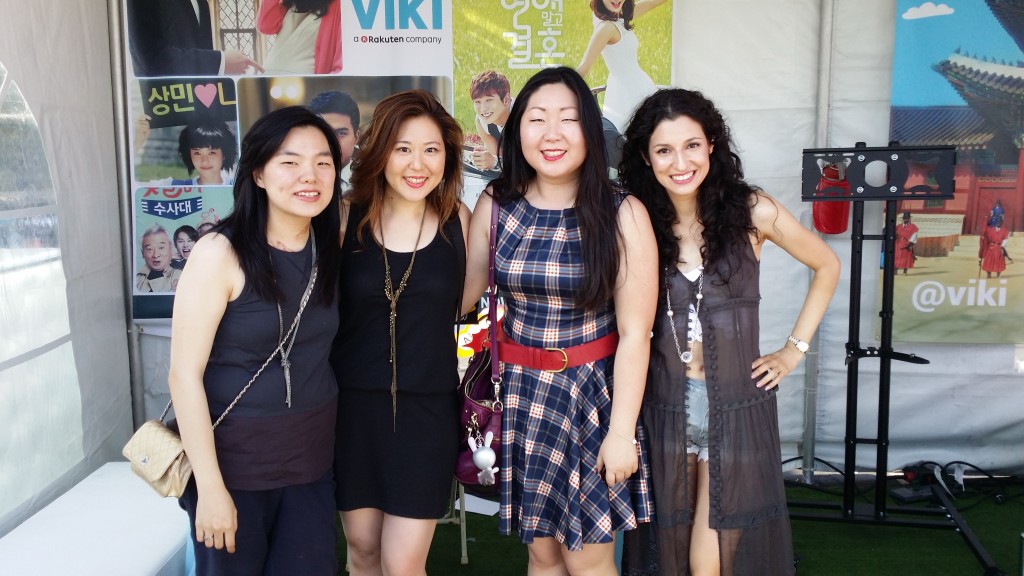- California Assembly OKs highest minimum wage in nation
- S. Korea unveils first graphic cigarette warnings
- US joins with South Korea, Japan in bid to deter North Korea
- LPGA golfer Chun In-gee finally back in action
- S. Korea won’t be top seed in final World Cup qualification round
- US men’s soccer misses 2nd straight Olympics
- US back on track in qualifying with 4-0 win over Guatemala
- High-intensity workout injuries spawn cottage industry
- CDC expands range of Zika mosquitoes into parts of Northeast
- Who knew? ‘The Walking Dead’ is helping families connect
Dramabeans: Guardians of the K-drama Galaxy
Many fans say the site is the source of blame for their K-drama addictions

Dramabeans runners Javabeans and Girlfriday, second and third from left, pose at KCON. (Courtesy of Dramabeans)
By Tae Hong
The two women behind Dramabeans, creator Javabeans and co-runner Girlfriday, are just fine being called by their well-known monikers in lieu of their real names, thank you.
After all, those monikers are the names associated with the foremost K-drama recap, news and discussion site for English speakers on the web.
All run, they say, by the most cliche and hokey of motivations: Doing it for the love of it, period.
Javabeans writes in her first WordPress blog post for the site in 2007, “Part of my latest set of distractions has been getting sucked into the world of K-dramas…They’re so incredibly addicting!”
“Incredibly addicting” was the right phrase for what she’d started. The site quickly grew into a haven for drama lovers, a community of fans drawn by industry news and episode recaps littered with witty — and often sassy — remarks.
Six years later, Dramabeans is a brand that has allowed the two writers to release a book (“Why Do Dramas Do That?”), expand their part-time staff by six to eight writers and even hold meetups, from New York to Seattle.
It was a hobby at the beginning. Javabeans, who grew up watching dramas but who only returned to them around the mid-2000s when series like “My Name is Kim Sam-soon” and “My Girl” burst into popularity, saw a lack of an online community where she could revel in in-depth discussions and obsess over little details episode-by-episode.
“I couldn’t find it, so I figured, I’ll have to make it,” she said. “Because I still wanted to talk about it. It caught on really quickly, which to me indicates that there was a vacuum, and there was an appetite for it. Nobody had done it yet.”

A screen capture of Dramabeans.
Girlfriday was first a reader of the site before officially becoming an editor in 2010. “I love television and discourse in the same way,” she said.
The two site runners eventually quit their day jobs and are now separated by a few hours’ distance, with Javabeans in Seattle and Girlfriday in Los Angeles. Although daily communication is easiest through, naturally, online tools like Skype, Google Docs and chatting, the pair occasionally fly back and forth to meet.
It’s an arrangement that works partly because they have so much in common when it comes to a lifetime of television watching, from their early exposure to Korean dramas as children to their love of “Buffy the Vampire Slayer” and “Veronica Mars” in their teenage years.
There’s another common factor, too: a background in writing, from freelancing to journalism to editing.
“We’re writers first,” Girlfriday said. “We’re professional writers first, and then we came to dramas, so we think about it differently, this process.”
Javabeans agreed. “If we weren’t running a blog about Korean dramas, we would probably be writing as much about something else. We love to write, and we love to talk about TV — it’s the perfect vehicle.”
It’s a vehicle that, for the time being, is set to keep on going.
“The minute I start resenting it because I’m doing it for another reason — because it has to pay my bills, because I need to get my traffic up, because I have to compete with another site — the minute those become my driving motivations is the moment I would probably go crazy and burn it down,” Javabeans said. “It’s too much for the wrong reasons.”
For Girlfriday, it’s the fun of the dramas as much as it is about the fun of sharing a connection with fans from all over the world who come to the site as members of a community. Dramabeans has become a place to vent, to theorize, to discuss.
“It’s knowing that it’s not just you writing alone in a vacuum,” Girlfriday said. “Everyone else is watching this show.”
By everyone, she means everyone. If K-pop forms one leg of Hallyu, the other is K-dramas.
To two Korean Americans who describe themselves as people of “the H.O.T. generation,” and who experienced life in the U.S. before the rise of Korean cool, the world’s current fascination with South Korean pop culture is baffling and completely amazing.
“When I was a child growing up, Korea was a very small country,” Javabeans said. “It was coming out of its third-world past. … [Korea] was a very different world socially, culturally, pop culturally. So now, it’s kind of cool that people are interested in my culture who are not of my culture. It’s cool. But weird.”
A talk with the folks behind Dramabeans would not be complete without drama talk.
“Television is a visual medium,” Javabeans said. “There’s no way to ignore that visual is important. If you’re going to say it’s only about the story and the dialogue, OK. Well then, you can read a book.”
Still, they say, story is king. Two, so is chemistry. Three, so is good editing and directing. Four, so are fresh takes on old tropes, beautiful shots, good acting. Javabeans loves Lee Je-hoon and “Gaksital”; for Girlfriday, it’s Lee Seung-ki and “Reply 1997.”
One thing they hear most often from readers is that Dramabeans is a gateway, the source of blame for many fans’ K-drama addictions.
“We don’t want to teach you in the form of an instructor,” Javabeans said. “We want to introduce you to a world and make it less behemoth-like. There’s so much in the world of dramas these days that if you were to enter it blind, it would just be overwhelming. We want to make sense of it for you, help you figure out what you like.”















